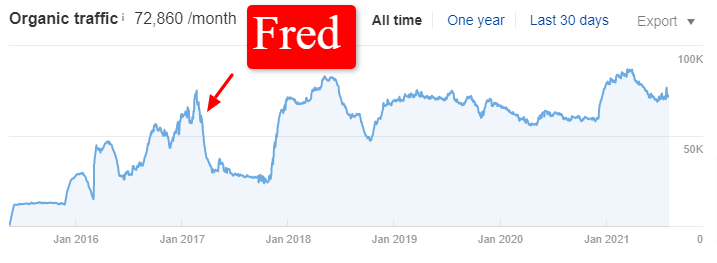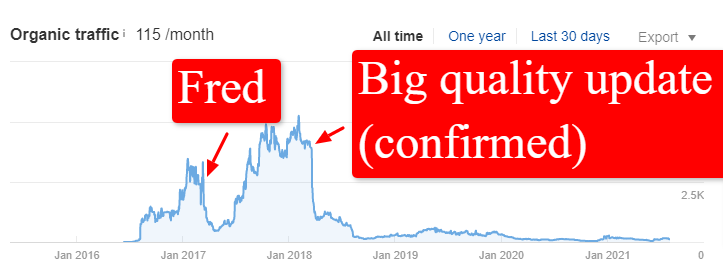March 8, 2017, was a day that started out like any other…
You were sat at your desk, casually sipping your first cup of coffee and catching up with the search news here on Search Engine Journal, or perhaps scrolling through your Facebook feed, when it hit you…

You headed over to your favorite rank-checking tool.
“Please God, just let my site/clients be OK,” you quietly prayed.
Depending on your strategies and sites, the impact was almost certainly significant. Losers lost big, and the winners took their place.
Fred was here.
Why Name the Algorithm Fred?
According to Google’s very sarcastic Gary Illyes, ‘Fred’ is the name of every update Google doesn’t give us a name for.
sure! From now on every update, unless otherwise stated, shall be called Fred
— Gary 鯨理/경리 Illyes (@methode) March 9, 2017
With that said, when we refer to the “Fred Update,” we are typically referring to the update that rolled out on March 7, 2017.
Unless otherwise noted, any reference to Fred below will be in this context and not a compilation of all the “unnamed” updates since then.
Fred’s Timing
Fred has interesting timing.
Fred was preceded a month earlier by a major Google Core Update, which was said to focus on E-A-T.
A week after Fred, Google announced Project Owl, which was designed to clear away misleading and offensive information based on feedback from their quality raters.
Now, let’s be clear: The raters were training the system to recognize inaccurate or offensive information, not making the decision as to what sites should be purged from the results.
Clearly, Google was highly focused on quality and using data from their quality raters.
Fred was no exception.
What Was Google’s Fred Algorithm?
Google’s Fred algorithm update rolled out in an attempt to remove what Google perceived as low-quality results — sites that relied on thin content and aggressive ad placement.
Many were affiliate sites, though not all.
The majority used content as their primary traffic driver. Ordinarily, we hear Google telling folks to do just that.
However, the quality of the content on the affected sites tended to be very low, with highly prevalent ads. You know the sites. You probably avoid them.
While Gary gave us a name for the update, he didn’t give us a list of the areas they were addressing aside from the statement:
Fred is closely related to quality section of rater guidelines. @methode #smx
— Jennifer Slegg (@jenstar) June 13, 2017
That tells us that it did have to do with E-A-T, and the impacted sites imply that the areas it targeted were some or all of:
- Too many ads.
- Thin content.
- Poor link quality.
- Poor content quality.
- Aggressive affiliate linking.
- Overwhelming interstitials.
- Deceptive ads (ads that appear as content).
- Disproportionate Main Content/Supplemental Content ratio.
If you want a refresher on E-A-T and the Quality Raters’ Guidelines, you’ll find one here.
From the Horse’s Mouth
Jenn Slegg interviewed Gary Illyes on the topic at Brighton SEO in 2017.
Here’s a transcript of their discussion.
When it came to Fred, it all came basically down to the following:
Freds, Not Fred
Gary reinforced in the interview that Fred is the name of every unnamed update. As noted above, that’s all well and good for him to state but is a bit useless for SEO pros.
This is why we are typically referring to the single update.
Google Doesn’t Like That We Care About Updates
Gary goes on to note,
“I don’t like that people are focusing on [updates]. Every single update that we make is around quality of the site or general quality, perceived quality of the site, content, and the links or whatever.”
They would rather we just focused our time and attention on meeting the user’s needs than analyzing updates and chasing the metrics they imply.
Most Updates are Unactionable
With two to three updates per day, Gary rightfully points out that most are addressing unactionable areas like how words are structured on a page in a specific language.
I just want to stress the use of the word “most.”
Links Matter
Gary says,
“Basically, if you publish high quality content that is highly cited on the internet …”
He goes on to be a bit tongue-in-cheek, but it’s clear that a goal should be building quality content that attracts links.
It’s not news or Fred-specific, but worth noting.
Q&A with Gary Illyes
You can watch a full video of the interview below. The portion on Fred begins at 4:30.
Dave’s Take
I’m not a huge fan of how Gary sort of sidesteps what Fred is by discussing it in the plural. He knows the question is about the March 7 update and not all of the Freds.
And the likelihood that they updated all the algorithms at once is… well, I suppose I can’t say 0%, but it’s as close to that as possible.
Other than that, his answers were predictable but revealing:
- Most updates aren’t actionable (in that there’s literally nothing that can be done – not that there are only things Google tells you they don’t want you to do like link building).
- All sites fluctuate.
- When in doubt, read the Webmaster Guidelines (and I would add the Quality Raters Guidelines).
- Gary is sarcastic and pretty funny.
Recovering From the Fred Update
Thankfully, if you’re ranking now, you’ve probably been doing the things that will keep you from getting hit by similar updates.
Those who wanted to recover from this update had a big, big task ahead of them. Typically, they needed to revisit their site structure to reduce the ad layout and on top of that, revisit their content page-by-page to ensure it actually deserved a spot in the top 10.
Some did. But many didn’t.
Some tried to shortcut it.
Barry Schwartz compiled a list of sites he knew to have been hit.
Here’s how some did:
https://electrical-engineering-portal.com/
 https://fullforminhindi.blogspot.com/
https://fullforminhindi.blogspot.com/

Seems they tried to trick their way back in.
http://entrancegeek.com

Looks familiar, but the second drop took a bit longer. The follow-up hit would be one of three updates.
- A flurry of manual actions were sent out around this time. This is the least likely.
- Quality updates that occurred around this time.
- And Marie Haynes reported seeing a number of sites impacted around June 17th and 18th that had previous link-related issues.
I suspect the third is the most likely.
http://www.faadooengineers.com/

Again, we see some recovery, and then subsequent hits in additional quality updates.
Google will get their way eventually.
Takeaway
Those who’ve been doing SEO recently will be used to updates like Fred, but in 2017 it was different than updates before it.
Stronger. More targeted. More effective. More devastating… or rewarding.
I remember when Fred rolled out. While my own clients weren’t impacted significantly one way or the other, it put a stamp on what was to come.
We’d seen quality updates and spam cleansers before, but this one somehow felt different. And it was.
After Fred, the updates around quality came more frequently and more varied. I credit that with the rise of machine learning but whatever the reason, as a searcher and someone who likes informative content, I appreciate it.
And hopefully, you feel you’ve found it here as well.
More Resources:
- 5 Ways to Build a Google Algorithm Update Resistant SEO Strategy
- 4 Ways to Prepare Your Clients for Algorithm Updates
- History of Google Algorithm Updates
Image Credits
Featured Image: Adobe Stock, edited by author
Karl Hindle’s Facebook post used with permission from Karl Hindle of Wellspring Digital
All screenshots taken by author, August of 2021





![[SEO, PPC & Attribution] Unlocking The Power Of Offline Marketing In A Digital World](https://www.searchenginejournal.com/wp-content/uploads/2025/03/sidebar1x-534.png)